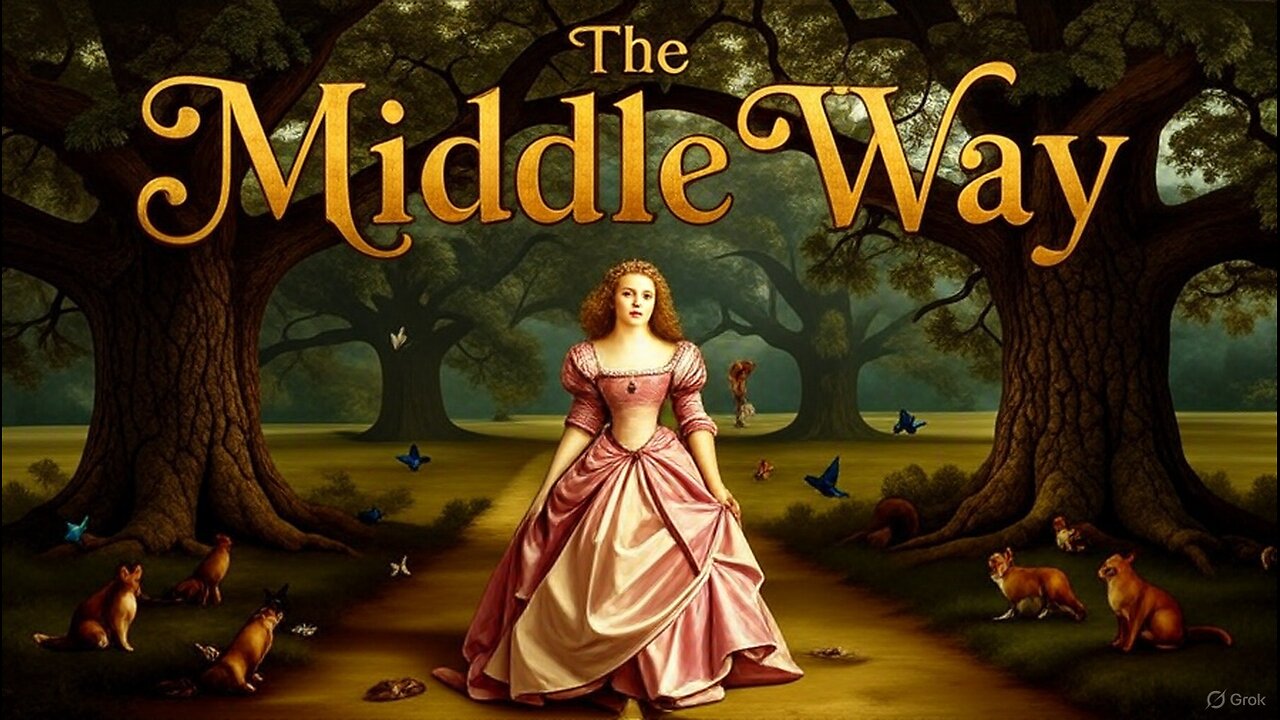Premium Only Content

Alan Watts: The Path of Balance
Alan Watts: The Path of BalanceBeneath a boundless, star-filled purple sky, where the light of day merges with the velvet darkness of night, a dense forest blazes with an untamed, roaring fire. The flames leap and twist, consuming ancient trees in a spectacle of destruction and renewal, their golden glow casting an ethereal light across the landscape. At the edge of this inferno, a circle of Buddhist monks sits in deep meditation, their orange robes a vivid contrast against the fiery chaos, their serene faces reflecting a profound inner stillness. This surreal scene serves as the allegorical gateway to Alan Watts: The Path of Balance, a profound exploration of the life, philosophy, and legacy of Alan Watts, the British-American philosopher and spiritual teacher who illuminated the Middle Way as a path of harmony between opposites, guiding humanity toward a balanced existence.The Early Foundations of a SeekerAlan Wilson Watts was born on January 6, 1915, in Chislehurst, England, into a modest middle-class family. His childhood was marked by a deep affinity for nature, as he wandered the English countryside, observing the delicate balance between growth and decay—a theme that would later underpin his philosophy. At age seven, a chance encounter with a Chinese scroll sparked a lifelong fascination with Eastern thought, particularly Buddhism’s Middle Way and Taoism’s principle of harmony. This curiosity led him to explore the works of mystics and philosophers as a teenager, laying the groundwork for a career that synthesized Eastern wisdom with Western perspectives.The forest fire in The Path of Balance symbolizes the dynamic tension of life’s opposites—creation and destruction, activity and rest— which Watts sought to harmonize. The monks, meditating amidst the flames, embody the Buddhist Middle Way, a practice of avoiding extremes that Watts embraced and reinterpreted. The star-filled purple sky, blending day and night, reflects his cosmic view that balance is the natural order of the universe, a theme he explored throughout his teachings.Watts’ intellectual journey took a pivotal turn when he moved to the United States in 1938, settling in New York City. There, he immersed himself in the study of Eastern religions through the Buddhist Lodge, briefly becoming an Episcopal priest before abandoning the role to pursue a broader spiritual vision. His 1951 publication of The Wisdom of Insecurity marked his emergence as a public intellectual, arguing that true balance lies in accepting life’s uncertainties rather than resisting them. This resonates with the fire’s unpredictable yet regenerative nature, suggesting that equilibrium emerges from embracing life’s flow.The Philosophy of the Middle WayAt the core of The Path of Balance lies Watts’ interpretation of the Middle Way, a concept rooted in Buddhism but expanded through his unique lens. The Buddha’s Middle Way navigates between the extremes of indulgence and asceticism, seeking a balanced path to enlightenment. Watts, however, broadened this idea to encompass all aspects of existence—mind and body, self and other, action and stillness. He taught that the mind’s tendency to polarize experience into opposites is an illusion, and that true harmony arises when one flows with the natural rhythm of life, much like water finding its level.The video explores this philosophy through a narrative that mirrors the journey toward balance. The forest fire represents the chaos of unintegrated opposites—desire and aversion, creation and destruction—while the monks’ meditation symbolizes the practice of centering oneself amidst this duality. The star-filled purple sky offers a cosmic perspective, suggesting that balance is not a static state but a dynamic dance, aligning with Watts’ metaphor of life as a playful waltz with the universe.Watts’ teachings were delivered with a distinctive blend of wit, poetry, and scholarly insight. His radio broadcasts on San Francisco’s KPFA in the 1950s, followed by books like The Book: On the Taboo Against Knowing Who You Are (1966) and Tao: The Watercourse Way (1975), brought this perspective to a global audience. He often used nature as a teaching tool, comparing balance to the interplay of yin and yang, where each pole contains the seed of its opposite. This ecological insight aligns with the burning forest, where the ashes nurture new growth, mirroring the inner harmony Watts sought to inspire.The Cultural Resonance and Personal JourneyThe 1960s marked the height of Watts’ influence, as his ideas resonated with the counterculture movement’s quest for a balanced life amid societal upheaval. Living in California, he engaged with figures like Aldous Huxley, Allen Ginsberg, and Timothy Leary, exploring psychedelics as a means to experience unity beyond duality—a pursuit that paralleled his philosophical work. His book The Joyous Cosmology (1962) documented these experiences, suggesting that altered states could reveal the middle path, a revelation visually echoed by the star-filled purple sky’s harmonious blend of light and dark.Watts’ personal life reflected his pursuit of balance. His houseboat in Sausalito, where he wrote and reflected, became a sanctuary for integrating work and leisure, often fueled by late-night conversations and nature’s rhythms. He spoke of balance as a lived experience, achieved through meditation, play, and acceptance of life’s impermanence. Yet, his health declined in the early 1970s, and he passed away on November 16, 1973, at age 58, leaving behind a legacy preserved in over 25 books and hundreds of recordings.The Path of Balance captures this legacy through a rich narrative, blending archival footage, animated sequences of the burning forest and meditating monks, and expert commentary. It delves into his views on harmony as a path to enlightenment, presenting them as a guide for modern living. The monks’ presence amidst the flames becomes a call to action—to find equilibrium amid life’s extremes.The Symbolic Imagery and Its DepthThe imagery of The Path of Balance is laden with symbolic resonance. The forest fire represents the tension of opposites—activity and rest, chaos and order—its flames a metaphor for the challenges of achieving balance. Its regenerative power reflects the potential for harmony that emerges from this tension, where destruction paves the way for renewal. The Buddhist monks, with their meditative stillness, embody the Middle Way, their orange robes a symbol of the life force that persists through duality.The star-filled purple sky is the narrative’s celestial guide, a reminder of the cosmic balance that transcends earthly conflicts. Purple, a color of mystery and royalty, suggests the divine equilibrium within, while the stars trace the cyclical nature of existence, connecting the microcosm of the self to the macrocosm of the universe. Together, these elements create a sensory experience that immerses viewers in Watts’ philosophy, making the abstract tangible.The Modern RelevanceAs of 04:10 PM PDT on Monday, September 29, 2025, The Path of Balance resonates with a world grappling with polarization, technological overload, and environmental crisis. Watts’ teachings offer a counterpoint to the extremes of consumerism and asceticism, advocating for a balanced lifestyle. The forest fire aligns with contemporary concerns about climate change, suggesting that harmony can emerge from destruction if approached with wisdom. The monks’ mindfulness practices find parallels in modern psychology’s embrace of balance for mental health.The video’s structure mirrors Watts’ nonlinear approach, moving fluidly between his life, teachings, and philosophical insights. It includes excerpts from his lectures, such as his analogy of balance as a tightrope walk between opposites, reinforcing the theme of harmony. Animated sequences depict the forest regenerating under the purple sky, symbolizing the potential for personal and planetary equilibrium, while the monks guide viewers through a virtual meditation to cultivate balance.The Journey Along the PathThe Path of Balance is structured as a contemplative odyssey, inviting viewers to explore the Middle Way. The narrative begins with the confrontation of the fire, a metaphor for the extremes of thought and emotion that disrupt harmony. As the monks guide the viewer through their practice, the focus shifts to integration and acceptance, culminating in a celestial perspective under the star-filled sky. This progression mirrors Watts’ belief that balance is a dynamic process, not a fixed state, requiring continual adjustment.The video incorporates interactive elements, such as guided meditations synced with the monks’ breathing and a balance journal feature inspired by Watts’ cosmic insights. These features, available as of September 2025, allow viewers to engage with the material personally, reflecting the idea that the path is both universal and individual. The monks’ avatars offer daily prompts, blending ancient wisdom with modern technology.The Initiatory Stages of BalanceThe journey is divided into three stages, each corresponding to a level of harmony:The Outer Path: Recognizing Duality
The first stage introduces viewers to the mind’s tendency to polarize experience. Through meditation, guided by the monks, they observe the fire’s chaos and their own reactions, learning to acknowledge opposites without judgment. Texts inspired by The Wisdom of Insecurity are studied, encouraging acceptance of life’s flux.
The Inner Path: Embracing the Flow
The second stage delves into the Taoist principle of Wu Wei, teaching viewers to flow with life’s natural rhythm. The star-filled purple sky becomes a focal point, with lessons on celestial cycles and their influence on balance. Rituals involving water—symbolizing the Tao—drawn from a virtual spring, reinforce this harmony.
The Inner Unity: Living the Middle Way
The final stage is reserved for those who integrate opposites, entering a state of dynamic equilibrium. In the virtual temple’s heart, beneath the open dome, viewers meditate as the fire’s glow merges with the starlight. This experience, inspired by Watts’ lectures, is one of unity, where the self dances with the cosmos.
The Legacy and FutureWatts’ influence extends into modern spirituality, psychology, and environmental thought, where his insights on balance align with research on well-being and sustainability. The Path of Balance honors this legacy, presenting his philosophy as a living tradition. The monks, silhouetted against the fading flames under the starlit sky, linger as a symbol of his enduring wisdom—a call to walk the Middle Way.As the forest regenerates and the purple sky continues its eternal cycle, Alan Watts: The Path of Balance stands as a beacon of harmony. Its future lies in its ability to inspire new generations, drawing seekers with the allure of a balanced life. Through this cinematic journey, viewers are invited to step into the fire of duality, sit with the monks, and gaze into the stars—finding the path of balance within the dance of existence.
-
 2:29:22
2:29:22
Alan Watts Remastered
29 days agoAlan Watts: Unveiling the Self
661 -
 2:15:09
2:15:09
Badlands Media
14 hours agoOnlyLands Ep. 27: Power Hour Hangover, Trump’s Wartime Shift, and Portland in Flames
63.1K16 -
 22:21
22:21
DeVory Darkins
4 hours ago $5.56 earnedRioters attack Portland ICE Facility as Democrats make shocking admission
7.86K58 -
 2:06:06
2:06:06
TimcastIRL
6 hours agoTrump DOJ Announces INTERVENTION In Portland Over Nick Sortor Arrest | Timcast IRL
208K338 -
 6:53:58
6:53:58
SpartakusLIVE
8 hours ago#1 All-American HERO with LUSCIOUS hair and AVERAGE forehead brings Friday Night HYPE
57.8K4 -
 3:06:43
3:06:43
Laura Loomer
5 hours agoEP147: Islamic Terror EXPLODES In The West After UK Synagogue Attack
37.9K39 -
 1:02:50
1:02:50
Flyover Conservatives
11 hours agoEric Trump: America’s Most Subpoenaed Man SPEAKS OUT! | FOC Show
33.8K7 -
 3:36:44
3:36:44
PandaSub2000
1 day agoSuper Mario Galaxy 1 & 2 | ULTRA BEST AT GAMES (Original Live Version)
21.6K2 -
 1:26:04
1:26:04
Glenn Greenwald
9 hours agoJournalist Ken Klippenstein on Trump's New Domestic Terrorism Memo; Glenn Takes Your Questions on Bari Weiss's CBS Role, His Interview with Nick Fuentes, and More | SYSTEM UPDATE #526
90.1K73 -
 3:49:14
3:49:14
SynthTrax & DJ Cheezus Livestreams
2 days agoFriday Night Synthwave 80s 90s Electronica and more DJ MIX Livestream GOTH NIGHT Special Edition
45K6
